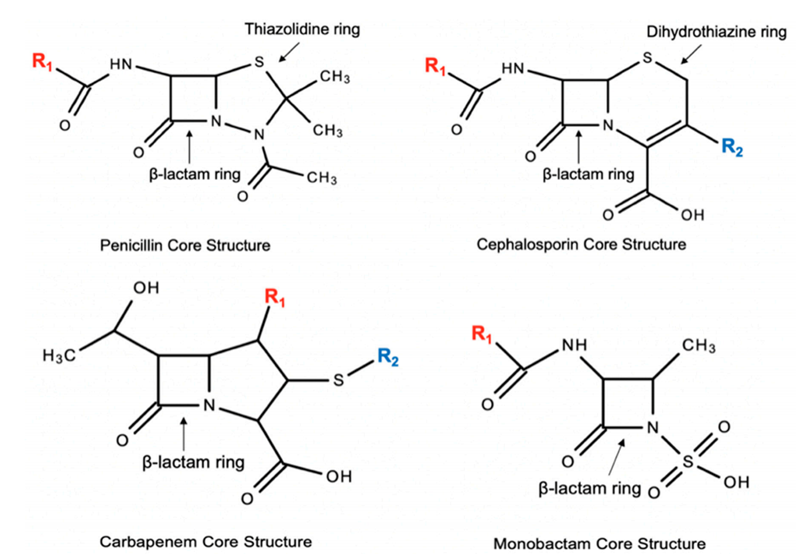
The key to penicillin allergy delabeling
What is the cross reactivity between Penicillin and cephalosporins?
Key Points
Among patients with an Immediate type (IgE-mediated) Penicillin allergy confirmed with skin testing:
- 97% tolerate cephalosporins
- 99% tolerate carbapenems
- 100% tolerate aztreonam (exception – ceftazidime allergy)
Rate of penicillin cephalosporin cross-reactivity is dependent on the generation of the cephalosporin
- 1st generation < 5%
- 2nd generation 2-5%
- 3rd generation < 1%
Cefazolin does not share side chain with any of the current FDA-approved beta-lactams (12) - Therefore Cefazolin is safe to use even with a severe penicillin allergy.
Aztreonam/ceftazidime cross-reactivity – due to shared R1 side chain
Penicillin and beta-lactams share the beta-lactam ring but differ with respect to the adjacent ring and the R-group side chains, R1 and R2. Penicillin-class beta-lactams have only an R1 group. The R1 side chain that is shared between some penicillins and cephalosporins, as well as among cephalosporins, has been shown to be a major driver of cross reactivity. Unlike cephalosporins and carbapenems, penicillins do not have R2 or additional side chain structures. The side chains of penicillins and first-generation cephalosporins are less complex than the side chains of later-generation cephalosporins. Although early studies indicated 5-10% cross-reactivity between penicillins and cephalosporins, contamination from the manufacturing process with penicillins was suspected to account for this cross reactivity.
Currently, no more than 2% of patients with positive reactions to multiple penicillin skin-test reagents have a reaction to cephalosporins (9), with the exception of patients who are allergic to aminopenicillins (ampicillin and amoxacillin) but not to benzyl penicillin, penicillin VK, and other penicillins (10). Such selective ampicillin/amoxacillin allergy has been uncommonly reported in the United States but appears to account for 1/3 of cases of penicillin allergy in southern Europe, where 25-35% of patients who are selectively allergic to ampicillin/amoxacillin have cross-reactivity with aminocephalosporins (cephalexin, cefadroxil and cefaclor). (9) This selective ampicillin/amoxacillin allergy is the basis for the use of amoxacillin rather than penicillin for the direct amoxacillin challenge.
Cefazolin does not share a similar side chain with any of the current FDA-approved beta-lactams.(12).
In 99% of patients with a history of penicillin allergy, performing a skin test and a challenge with carbapenems are associated with acceptable side-effects profile. (11) There appears to be no immunologic or clinical cross-reactivity between penicillins and aztreonam (monobactam). However, in patients who are allergic to ceftazidime there have been reports of aztreonam reactions which are due to a shared R1 side chain.

